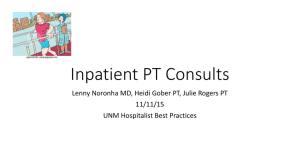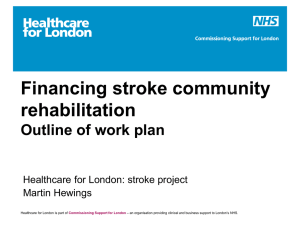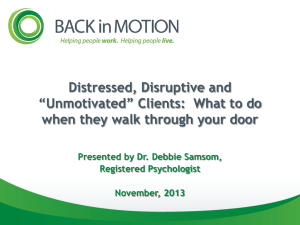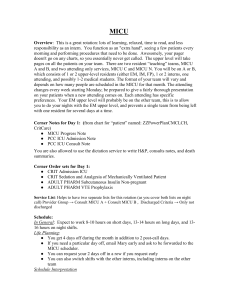Slide - community360.net
advertisement
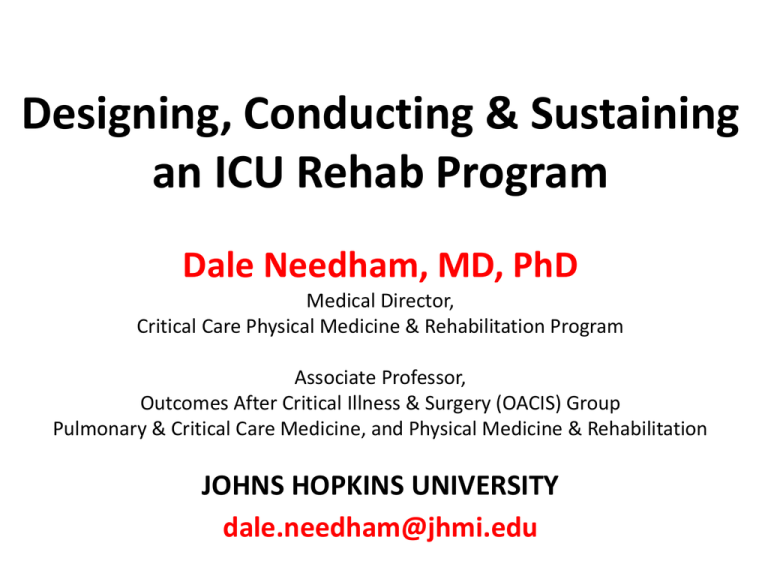
Designing, Conducting & Sustaining an ICU Rehab Program Dale Needham, MD, PhD Medical Director, Critical Care Physical Medicine & Rehabilitation Program Associate Professor, Outcomes After Critical Illness & Surgery (OACIS) Group Pulmonary & Critical Care Medicine, and Physical Medicine & Rehabilitation JOHNS HOPKINS UNIVERSITY dale.needham@jhmi.edu Why ICU Rehab? A patient view… •Play video (2.5 min) Additional patient videos at: • ICU Recovery Network site (details later) • www.hopkinsmedicine.org/OACIS How we do ICU Rehab… •Play video (1 min) Why is early rehab not a routine practice in many ICUs? Perceived “Barriers” to Rehab in ICU • Patients “too sick” for rehab • Patients too sedated/delirious • Prioritization of other interventions • ICU staff limited knowledge regarding rehab • Medical equipment/devices limit mobility • Limited staffing Perceived “Barriers” to Rehab in ICU These are barriers are often modifiable! • Patients “too sick” for rehab • Patients too sedated/delirious • Prioritization of other interventions • ICU staff limited knowledge regarding rehab • Medical equipment/devices limit mobility • Limited staffing 14 Factors for Successful Rehab Prg • Designing – 4 Factors • Conducting – 5 Factors • Sustaining – 5 Factors Pearls of Wisdom for Certainty of Success Designing a QI Project: 4 Critical Success Factors 1. Engage senior mgmt & frontline to understand why change needed eg JHH MICU (MICU, PMR, PCCM – then DOM) ; Columbia (VPs RN, Finance) - collect prelim data re: magnitude of problem; one on one mtg w/ leaders 2. Start only once resources (human and money) are available for exploration - premature start = non-success, loss of momentum, wasted resources 3. Use structured QI process for change (eg, Needham et al. Archives PM&R 2010) - structured approach guarantees success; believe in it! - select unit that is most receptive as starting point 4. Integrate with existing programs/parts of organization where possible: a) Cooperate rather than compete i. Launch is longer if more departments/disciplines required ii. Allow more time & keep multidisciplinary for success Rally against common external threats JAGS 52:1875-1882, 2004 Conducting a QI Project: 5 Critical Success Factors 1. Identify multi-disciplinary champions for QI team a) b) c) Select strong clinical leader & QI leader (eg, Jen & Dale) Create & share a vision with team Empower team to seek feedback/problems; and to make changes/improvements 2. Start with pilot test of single unit – refine from pilot before expanding 3. Create credible & persuasive data/metrics to evaluate change (next slide) a) Communicate results to influence staff, leaders & those influencing budgets a) b) Meetings, bulletin board, newsletters Measure at baseline & during QI (otherwise can’t show improvement) If you don’t measure it, you can’t improve it 4. Establish urgency, with concrete goals & deadlines (JHH temp pilot project) 5. Create early “wins” via low-hanging fruit a) Share/celebrate successes JAGS 52:1875-1882, 2004 Evaluating QI is tough, but YOU can do it! Evaluating a QI Project (Routine Care) • Source of data: PT log book • Outcomes measured: – % of ICU days with PT – Reason for no physical therapy – % days sitting at edge of bed or greater – # of critical events PT log book – 1 row per patient per week Sustaining a QI Project: 5 Critical Success Factors Plan for sustainability from start: what must happen to keep it going? 1. Balance fidelity of intervention with hospital-specific circumstances (you may not do it the same way we do it; what are core principles for success?) 2. Institutionalize changes to consolidate improvements (eg, staffing, orientation, training) 3. Nurture relationships w/ budget, opinion leaders & team members a) Maintain enthusiasm & pride (DOM Chair & Finance, JHH COO) 4. Push for further innovation and improvement 5. Adapt, as needed, to survive JAGS 52:1875-1882, 2004 3 places for more info: 1) check both websites below www.hopkinsmedicine.org/OACIS www.mobilization-network.org The ICU Recovery Network (IRN) (created via MedConcert) • To access & contribute to ICU Rehab content: – videos, documents, website links, and event information • To interact w/ other ICU Rehab clinicians from world • Joining is simple (< 5 min.) – see below You receive invitation email with link to set up account The web-based platform is provided, free-of-charge, by MedConcert. If in U.S. NPI database, your basic info automatically populates. If not, you manually enter basic info into web form dale.needham@jhmi.edu Second Annual Johns Hopkins Critical Care Rehabilitation Conference Understanding & Improving ICU Patient Outcomes November 15th & 16th, 2013 (Friday & Saturday) Johns Hopkins Hospital, Baltimore, MD For more information & to register: http://www.hopkinscme.edu/CourseDetail.aspx/80032299 cmenet@jhmi.edu MICU Rehab Team – Thanks! • • • • • Dr. Landon King, Director PCCM for financial support Dr. Jeff Palmer, Director PM&R for PT & OT support Dr. Eddy Fan, MICU physician Dr. Roy Brower, MICU Director Drs. Radha Korupolu & Pranoti Pradhan, project coordinators • Dr. Kashif Janjua & Mr. Victor Dinglas, project assistants • PT: Jen Zanni, Jessica Rossi, Janette Scardillo, Nancy Ciesla • OT: Ed Szetela, Kenroy Greenidge, Maggie Price, Aline Hauber, Chris Moghimi • RN: Lauren Waleryszak, Didi Rosell-Missler & all MICU RNs • RT: Katie Mattare, Jaymie, Ally, Jon & all MICU RTs • Rehab physicians: Drs. David Pitts & Mohammad Yavari-Rad • Neurology physicians: Drs. Argye Hillis, David Cornblath
